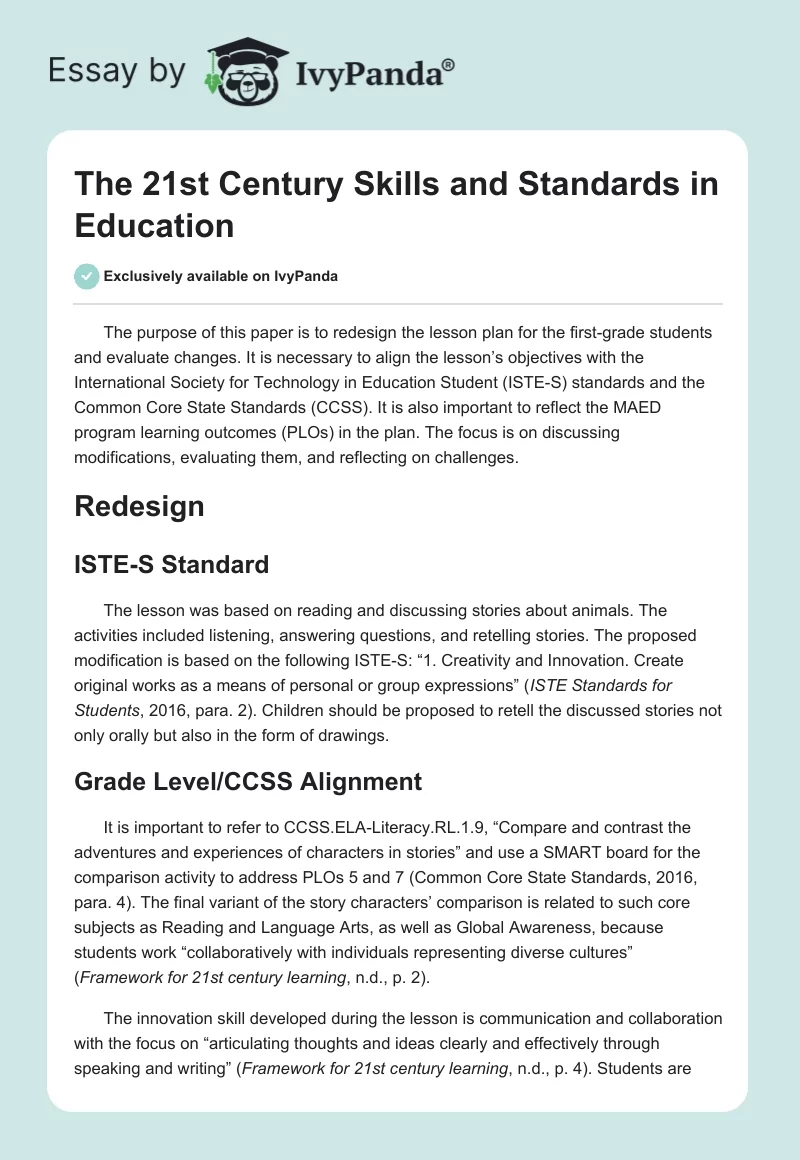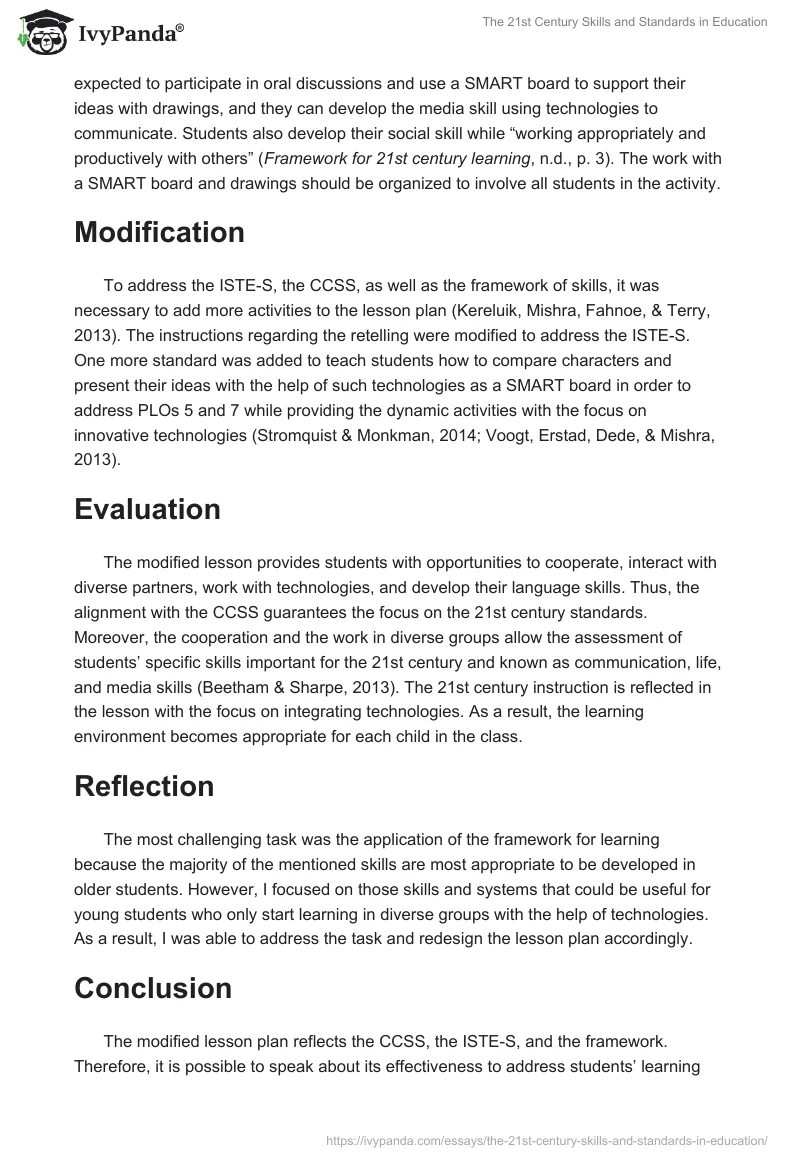The purpose of this paper is to redesign the lesson plan for the first-grade students and evaluate changes. It is necessary to align the lesson’s objectives with the International Society for Technology in Education Student (ISTE-S) standards and the Common Core State Standards (CCSS). It is also important to reflect the MAED program learning outcomes (PLOs) in the plan. The focus is on discussing modifications, evaluating them, and reflecting on challenges.
Redesign
ISTE-S Standard
The lesson was based on reading and discussing stories about animals. The activities included listening, answering questions, and retelling stories. The proposed modification is based on the following ISTE-S: “1. Creativity and Innovation. Create original works as a means of personal or group expressions” (ISTE Standards for Students, 2016, para. 2). Children should be proposed to retell the discussed stories not only orally but also in the form of drawings.
Grade Level/CCSS Alignment
It is important to refer to CCSS.ELA-Literacy.RL.1.9, “Compare and contrast the adventures and experiences of characters in stories” and use a SMART board for the comparison activity to address PLOs 5 and 7 (Common Core State Standards, 2016, para. 4). The final variant of the story characters’ comparison is related to such core subjects as Reading and Language Arts, as well as Global Awareness, because students work “collaboratively with individuals representing diverse cultures” (Framework for 21st century learning, n.d., p. 2).
The innovation skill developed during the lesson is communication and collaboration with the focus on “articulating thoughts and ideas clearly and effectively through speaking and writing” (Framework for 21st century learning, n.d., p. 4). Students are expected to participate in oral discussions and use a SMART board to support their ideas with drawings, and they can develop the media skill using technologies to communicate. Students also develop their social skill while “working appropriately and productively with others” (Framework for 21st century learning, n.d., p. 3). The work with a SMART board and drawings should be organized to involve all students in the activity.
Modification
To address the ISTE-S, the CCSS, as well as the framework of skills, it was necessary to add more activities to the lesson plan (Kereluik, Mishra, Fahnoe, & Terry, 2013). The instructions regarding the retelling were modified to address the ISTE-S. One more standard was added to teach students how to compare characters and present their ideas with the help of such technologies as a SMART board in order to address PLOs 5 and 7 while providing the dynamic activities with the focus on innovative technologies (Stromquist & Monkman, 2014; Voogt, Erstad, Dede, & Mishra, 2013).
Evaluation
The modified lesson provides students with opportunities to cooperate, interact with diverse partners, work with technologies, and develop their language skills. Thus, the alignment with the CCSS guarantees the focus on the 21st century standards. Moreover, the cooperation and the work in diverse groups allow the assessment of students’ specific skills important for the 21st century and known as communication, life, and media skills (Beetham & Sharpe, 2013). The 21st century instruction is reflected in the lesson with the focus on integrating technologies. As a result, the learning environment becomes appropriate for each child in the class.
Reflection
The most challenging task was the application of the framework for learning because the majority of the mentioned skills are most appropriate to be developed in older students. However, I focused on those skills and systems that could be useful for young students who only start learning in diverse groups with the help of technologies. As a result, I was able to address the task and redesign the lesson plan accordingly.
Conclusion
The modified lesson plan reflects the CCSS, the ISTE-S, and the framework. Therefore, it is possible to speak about its effectiveness to address students’ learning and development needs. Furthermore, the learner-centered instruction is based on the integration of technologies in the plan, and this aspect addresses requirements regarding the application of PLOs in the work. Students become able to develop their skills in reading, retelling, and interacting in diverse groups.
References
Beetham, H., & Sharpe, R. (2013). Rethinking pedagogy for a digital age: Designing for 21st century learning. New York, NY: Routledge.
Common Core State Standards. (2016). English Language Arts Standards: Reading, Literature, Grade 1. Web.
Framework for 21st century learning. (n.d.). Web.
ISTE Standards for Students. (2016). Web.
Kereluik, K., Mishra, P., Fahnoe, C., & Terry, L. (2013). What knowledge is of most worth: Teacher knowledge for 21st century learning. Journal of Digital Learning in Teacher Education, 29(4), 127-140.
Stromquist, N. P., & Monkman, K. (2014). Globalization and education: Integration and contestation across cultures. New York, NY: R&L Education.
Voogt, J., Erstad, O., Dede, C., & Mishra, P. (2013). Challenges to learning and schooling in the digital networked world of the 21st century. Journal of Computer Assisted Learning, 29(5), 403-413.


